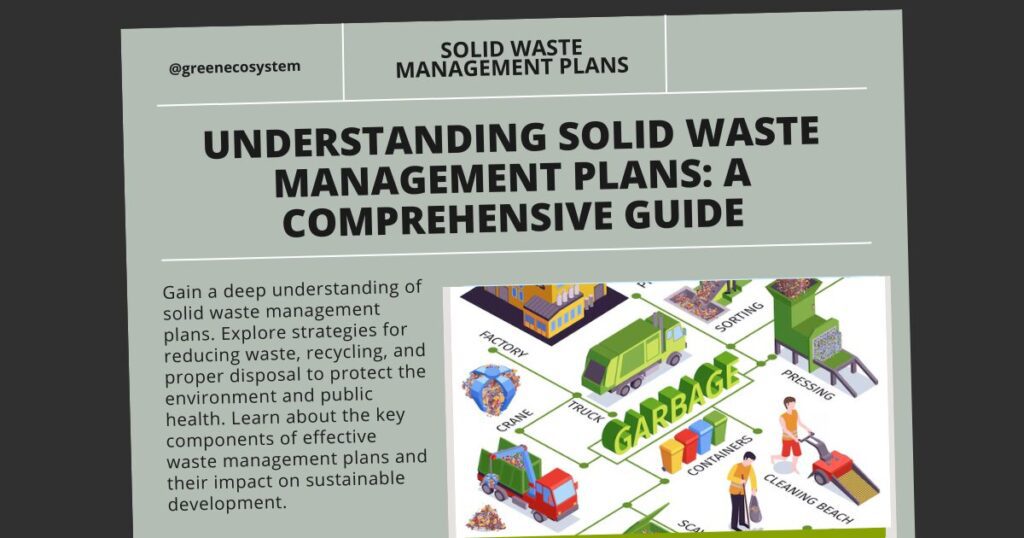Solid waste management is a critical aspect of environmental sustainability, particularly as communities strive to reduce their environmental footprint and achieve zero waste goals. A Solid Waste Management Plan (SWMP) is a strategic document that outlines a jurisdiction’s approach to managing solid waste over a specified period. This article delves into the components, importance, and implementation of solid waste management plans, drawing on examples from Arlington County and guidelines provided by USAID’s Clean Cities, Blue Ocean program.
Key Components of a Solid Waste Management Plan
1. Assessment of Current Waste Streams
The first step in developing an SWMP is to conduct a thorough assessment of the current waste streams. This includes identifying the types and volumes of waste generated, as well as the sources of this waste. This baseline data is crucial for setting realistic goals and developing effective strategies.
2. Goal Setting
Setting clear, measurable goals is essential for the success of any SWMP. These goals should align with broader environmental and sustainability objectives. For instance, Arlington County has set a target of at least 90% waste diversion from landfill or incineration by 2038.
Goals can include increasing recycling rates, reducing waste generation, and promoting composting.
3. Strategies and Actions
Once goals are established, the SWMP outlines the strategies and actions needed to achieve them. These can include: Recycling Programs: Implementing and expanding recycling programs to capture more materials. Waste Reduction Initiatives: Encouraging businesses and residents to reduce waste through education and incentives. Composting: Promoting composting to divert organic waste from landfills. Waste-to-Energy Technologies: Exploring and implementing technologies that convert waste into energy.
4. Public Engagement and Education
Public engagement is a critical component of any SWMP. Involving the community in the planning process ensures that the plan reflects the needs and values of the local population. Arlington County, for example, has established a Solid Waste Committee (SWC) to represent community interests and provide input on the SWMP.
5. Monitoring and Evaluation
Regular monitoring and evaluation are necessary to track progress and make adjustments as needed. This includes setting key performance indicators (KPIs) and conducting periodic audits to assess the effectiveness of the implemented strategies.
Importance of Solid Waste Management Plans
1. Environmental Benefits
Effective solid waste management reduces the environmental impact of waste, including greenhouse gas emissions, soil and water contamination, and the depletion of natural resources. By promoting recycling and composting, SWMPs help conserve resources and reduce the need for landfills and incineration.
2. Economic Benefits
Proper waste management can also lead to economic benefits. Recycling and waste reduction initiatives can create jobs, reduce disposal costs, and generate revenue from the sale of recycled materials. Additionally, waste-to-energy technologies can provide a sustainable source of energy.
3. Social Benefits
Community involvement in the development and implementation of SWMPs fosters a sense of ownership and responsibility. This can lead to increased participation in waste reduction and recycling programs, ultimately contributing to a cleaner and more sustainable environment.
Case Study: Arlington County’s Solid Waste Management Plan
Arlington County’s SWMP is a prime example of a comprehensive and forward-thinking approach to solid waste management. The plan, which must be adopted by the County Board no later than July 1, 2024, incorporates zero waste principles and aims to achieve a 90% waste diversion rate by 2038.
Key Features of the Arlington SWMP
Zero Waste Principles: The plan emphasizes the reduction, reuse, and recycling of materials to minimize waste. Community Engagement: The Solid Waste Committee (SWC) plays a crucial role in representing community interests and providing feedback on the plan. Innovative Strategies: The plan includes innovative strategies such as expanded recycling programs, composting initiatives, and the exploration of waste-to-energy technologies. Regular Monitoring: The plan includes provisions for regular monitoring and evaluation to ensure that goals are being met and to make necessary adjustments.
Visualizing the Impact of Solid Waste Management
Pie Chart: Waste Composition in Arlington County
To better understand the composition of waste in Arlington County, a pie chart can provide a visual representation of the different types of waste generated and their proportions.
Conclusion
Solid waste management plans are essential tools for achieving environmental, economic, and social sustainability. By setting clear goals, implementing effective strategies, and engaging the community, jurisdictions can significantly reduce their waste and move closer to zero waste targets. The example of Arlington County demonstrates the importance of a comprehensive and inclusive approach to solid waste management, providing a model for other communities to follow.

